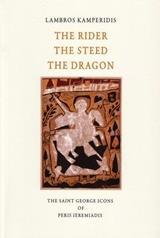THE RIDER, THE STEED, THE DRAGON
Lambros Kamperidis's study of Peris Ieremiadis is a work of therapy for our times. Not our modern introspection, but therapeia, the attending to and healing of wounds that sever the relationships between ourselves and others. This therapy is bodily, visceral, full of colour and of darkness. The death of his friend who spent his last creative energies painting variations of dragon-slaying Saint George on his regal horse triggers in Kamperidis an exuberant litany of associations, a delicate interlace linking pagan and Christian, Germanic and Greek, spiritual heroes and evil monsters. Kamperidis makes us all part of the interlace, for it is precisely through awareness of our interconnected nature that the therapy can begin to work. Through the impatient and spell-binding movements of his imagination, Kamperidis shows the reader how to reconnect the pieces in a fragmented world.
Elizabeth Key Fowden
The author of this book endeavours to show that human existence cannot be understood only by the laws that govern natural life. The human person emerges out of the struggle with the forces that are lurking to annihilate the freedom of the human being. What finally emerges is the free person, endowed with a unique and distinct soul, a singular existence owing his or her being not to biological origins but to a destination pointing towards eternity. Often, this encounter takes the form of artistic creation, as in the case of Peris Ieremiadis, the painter whose struggle with the evil of illness and his numerous depictions of Saint George inspired Lambros Kamperidis to create this work 'towards a Life of the Saint for our times'.
Lakis Proguidis

 engine
🛠20220509.145534
engine
🛠20220509.145534





